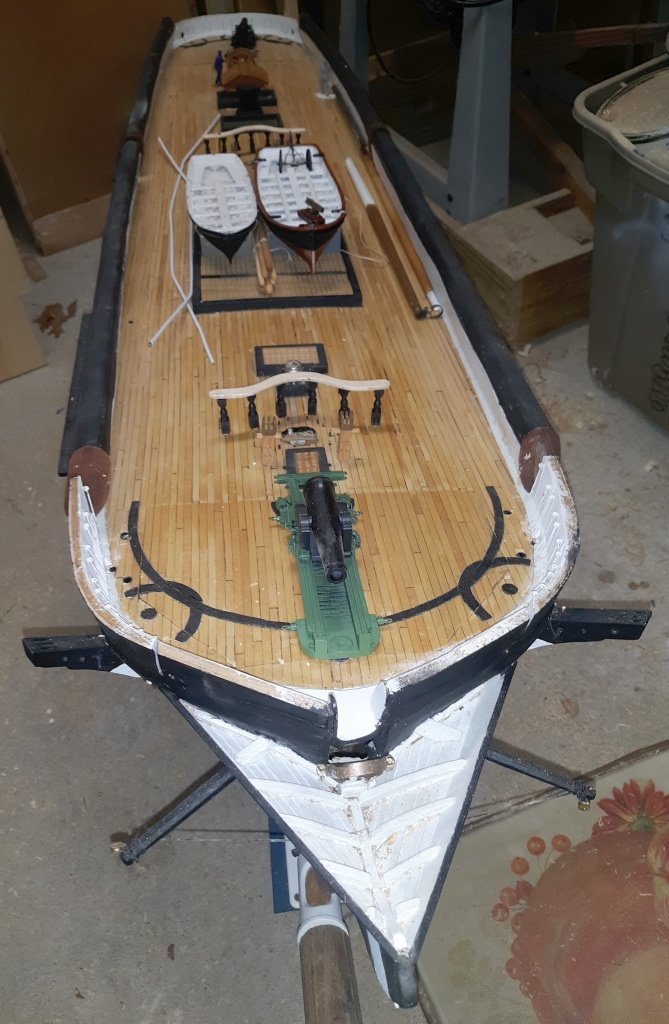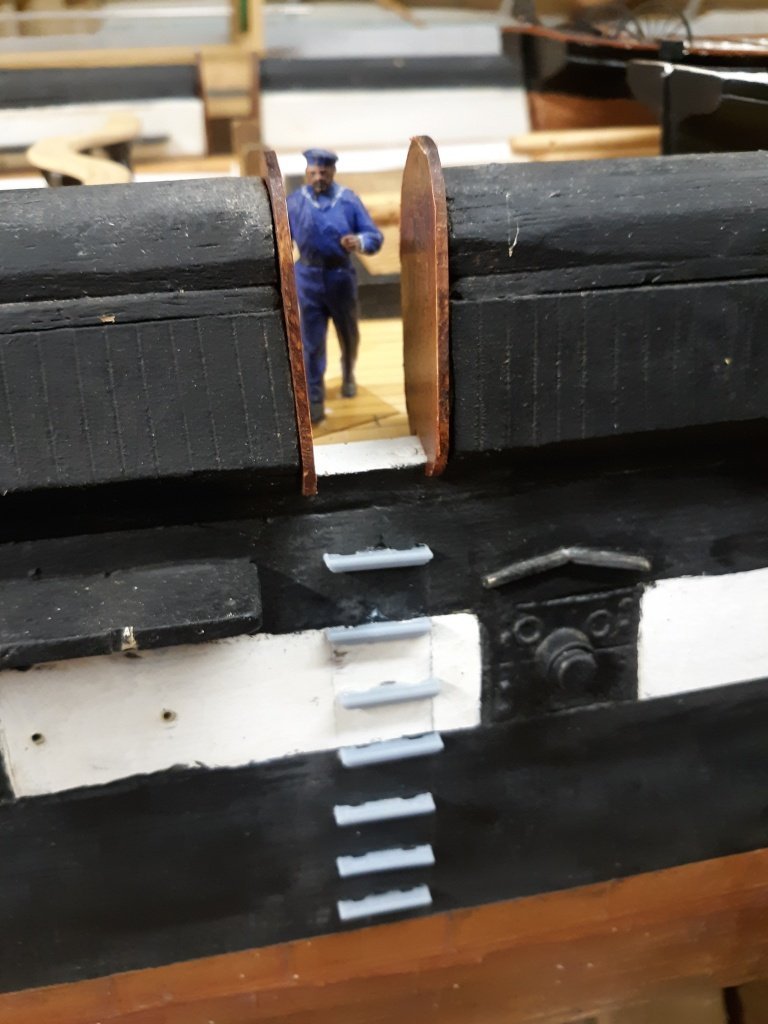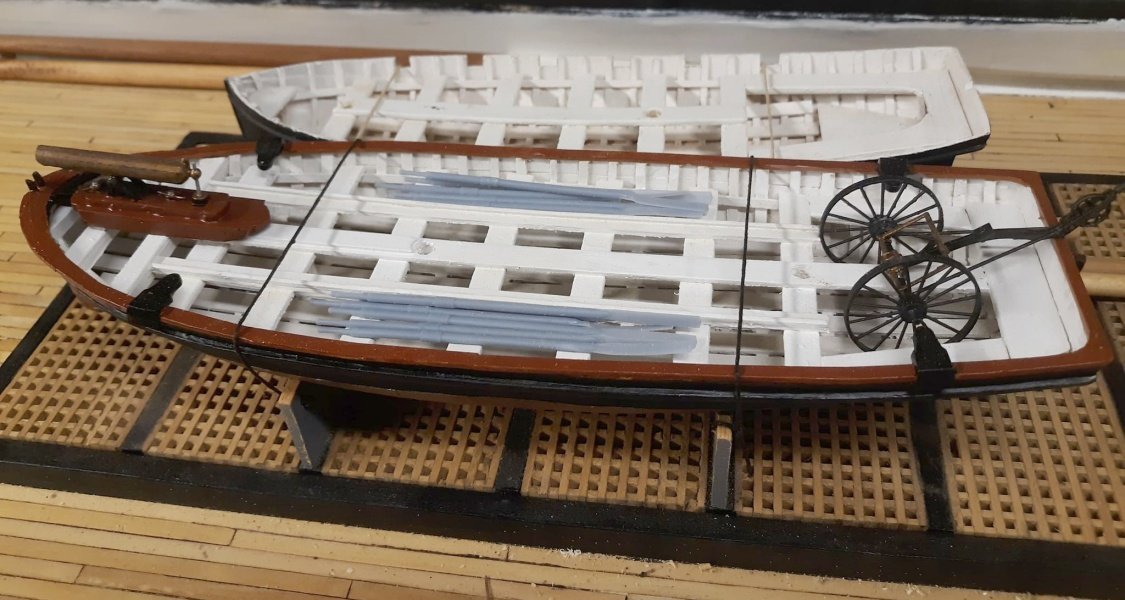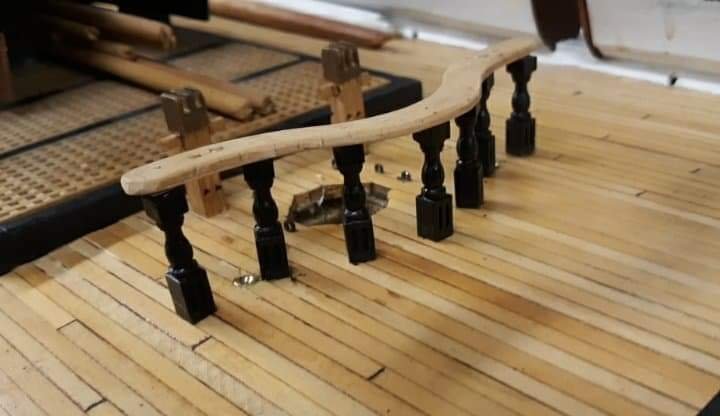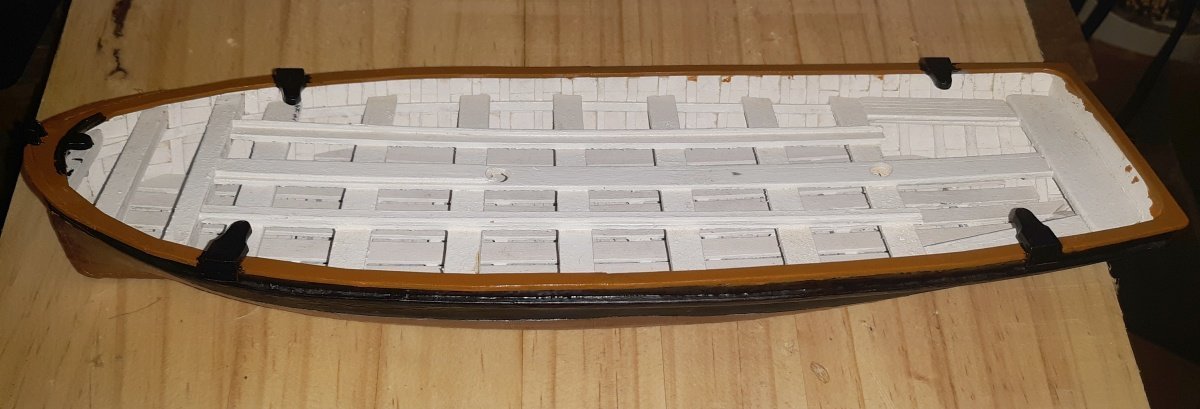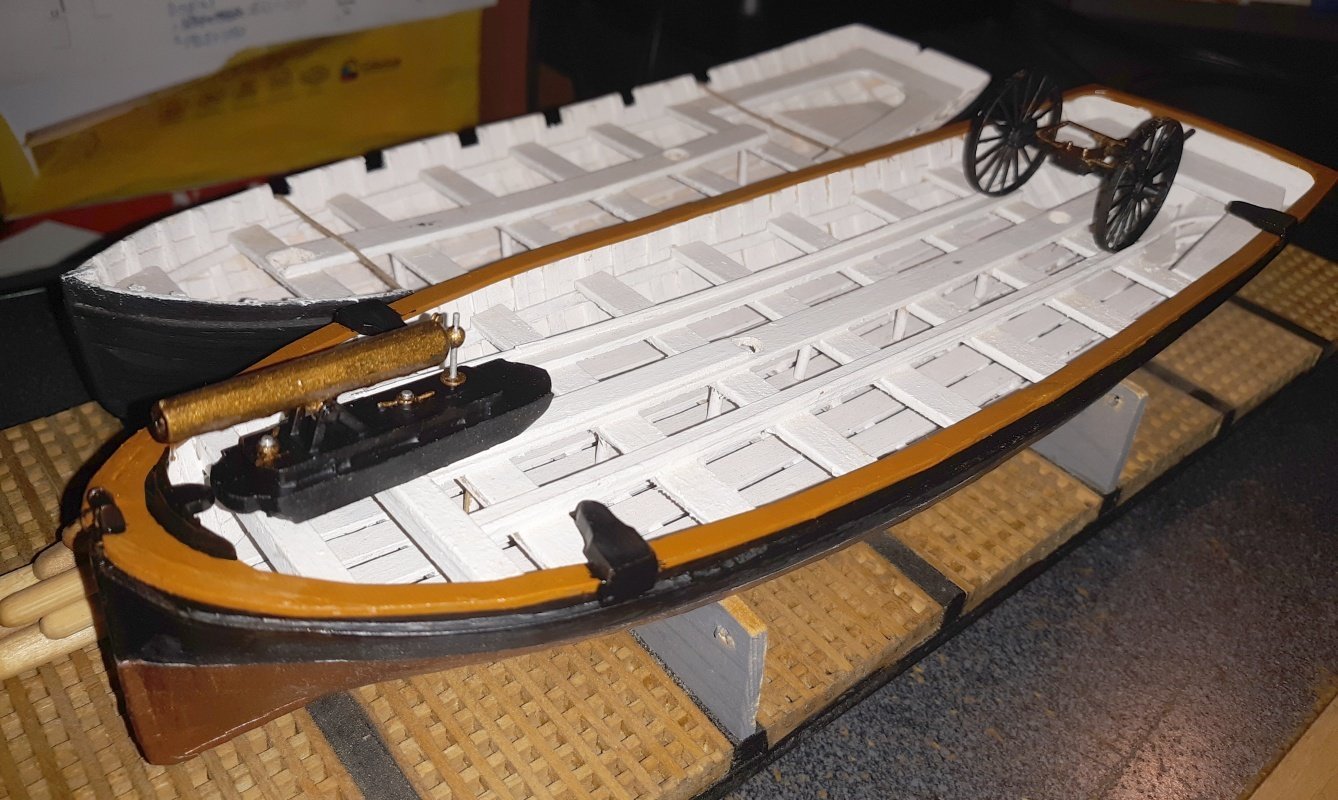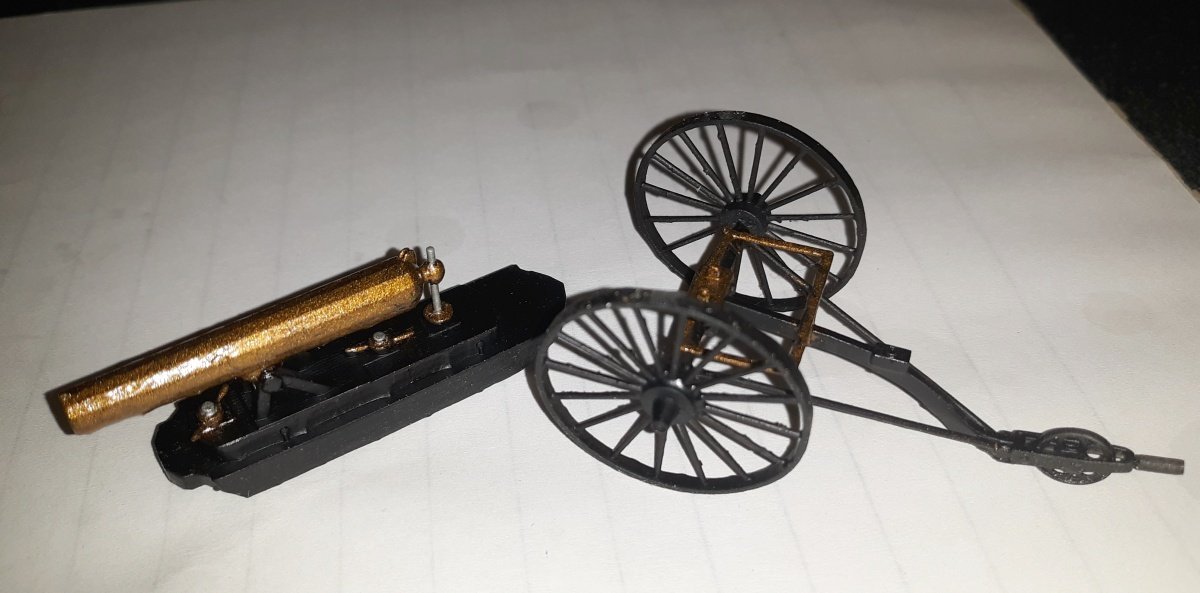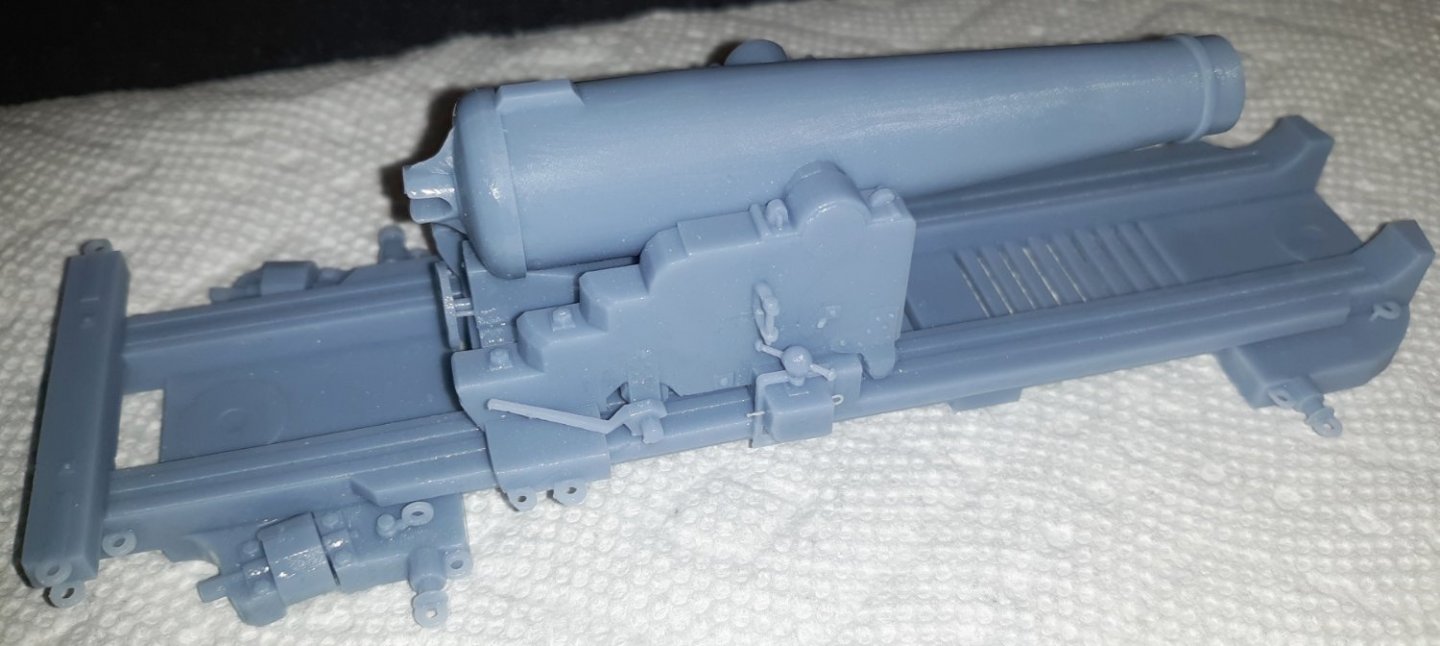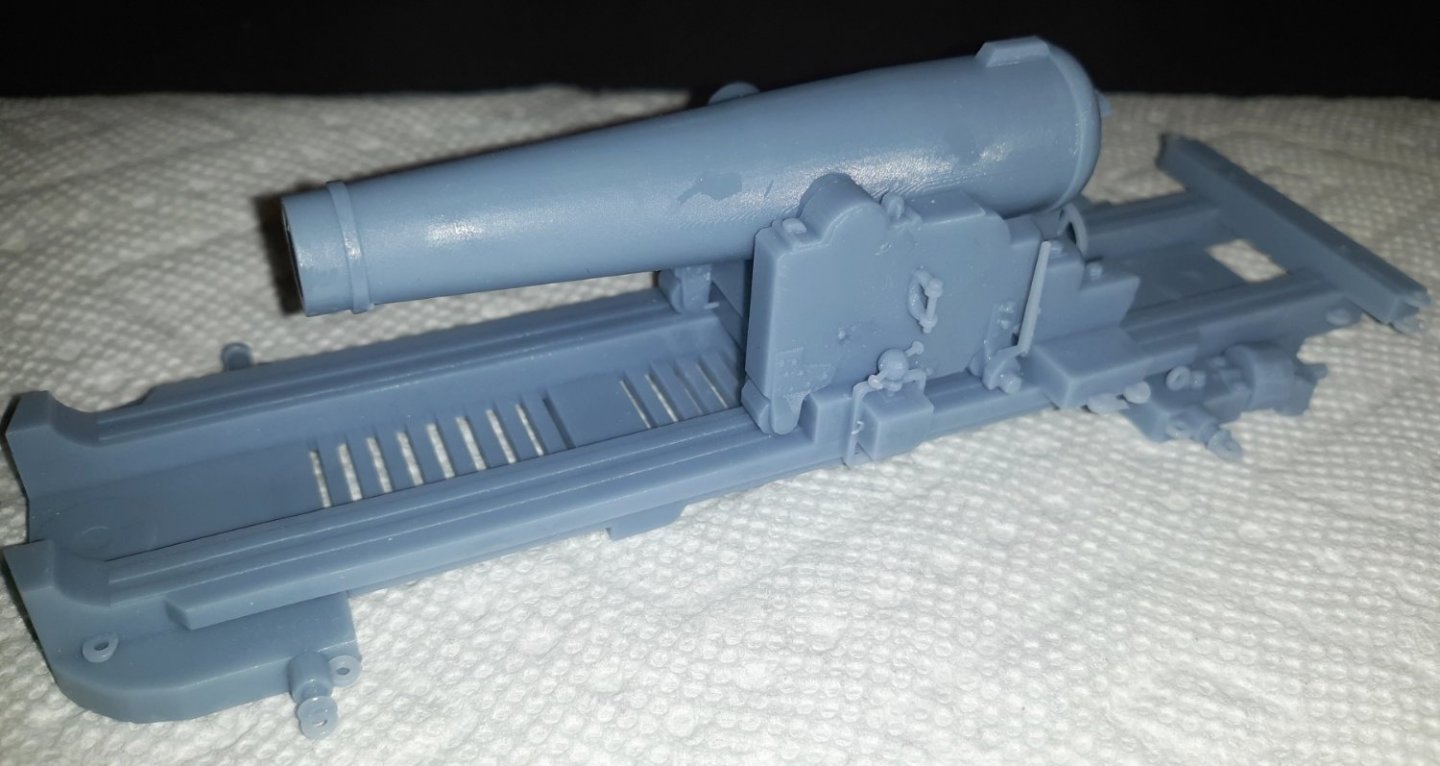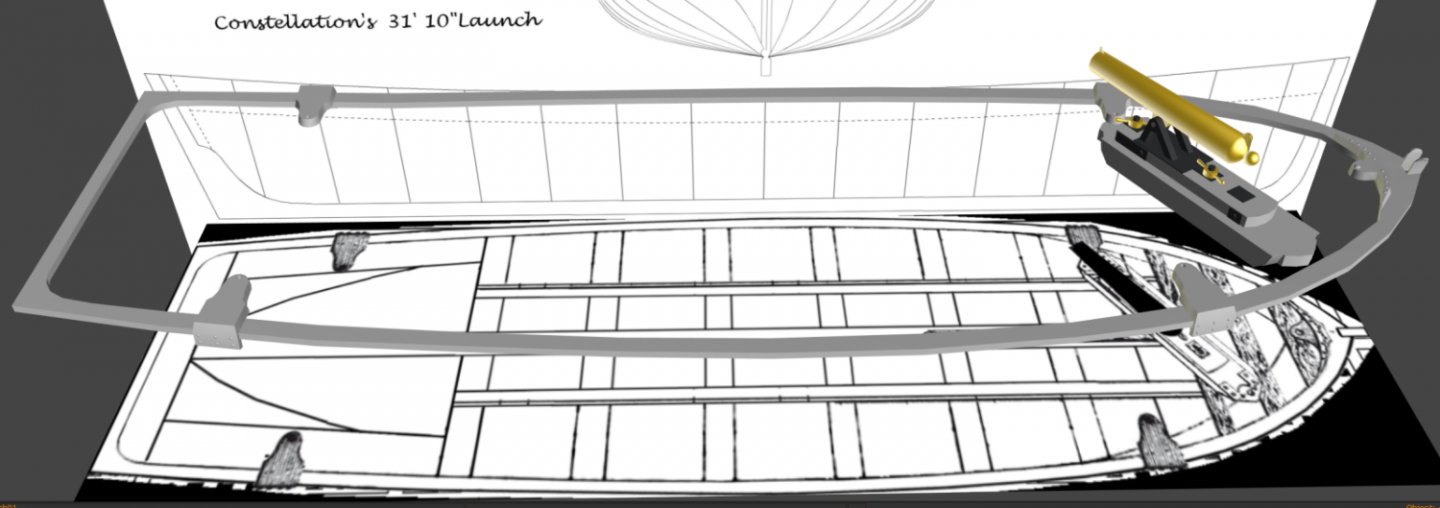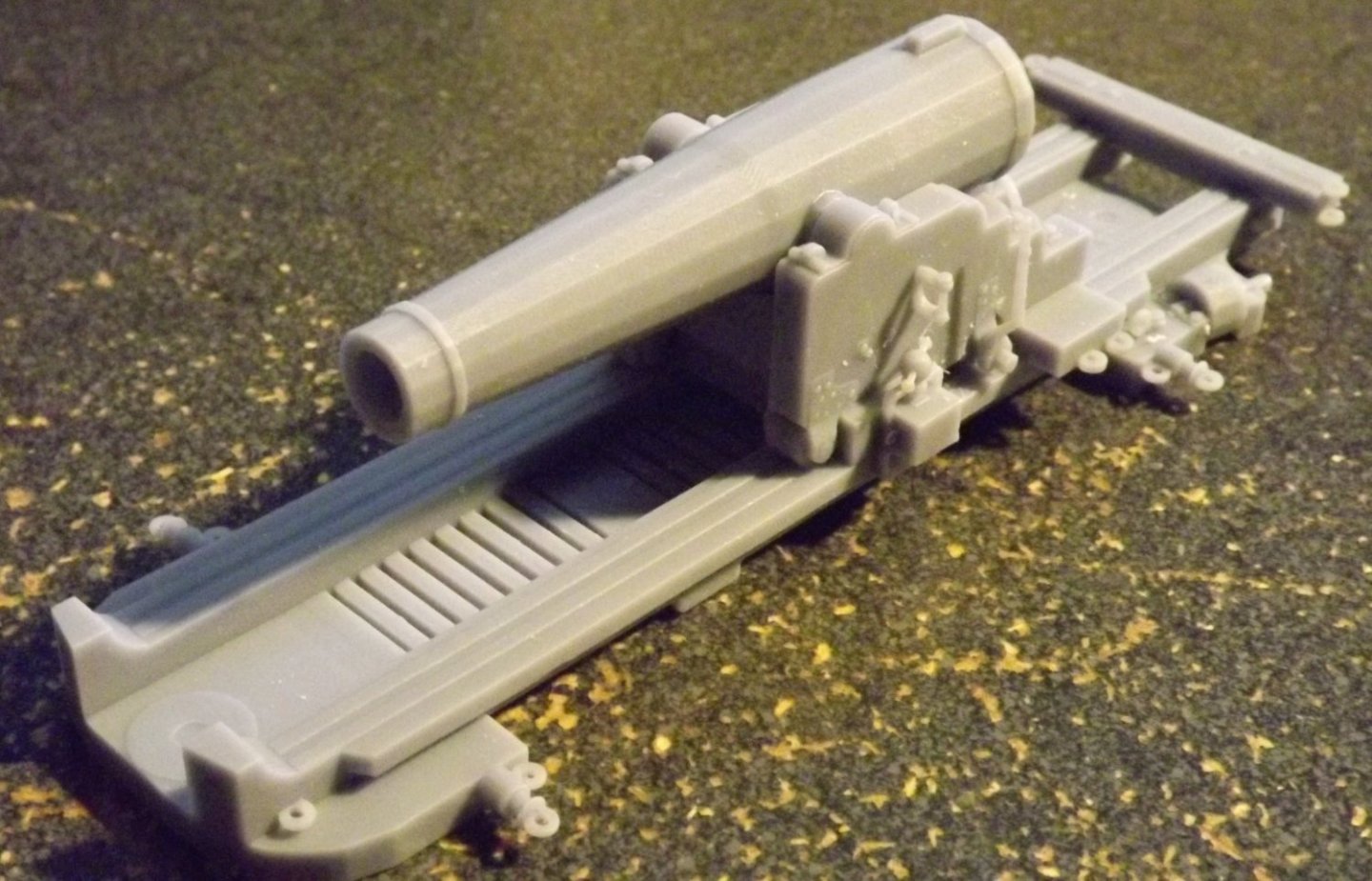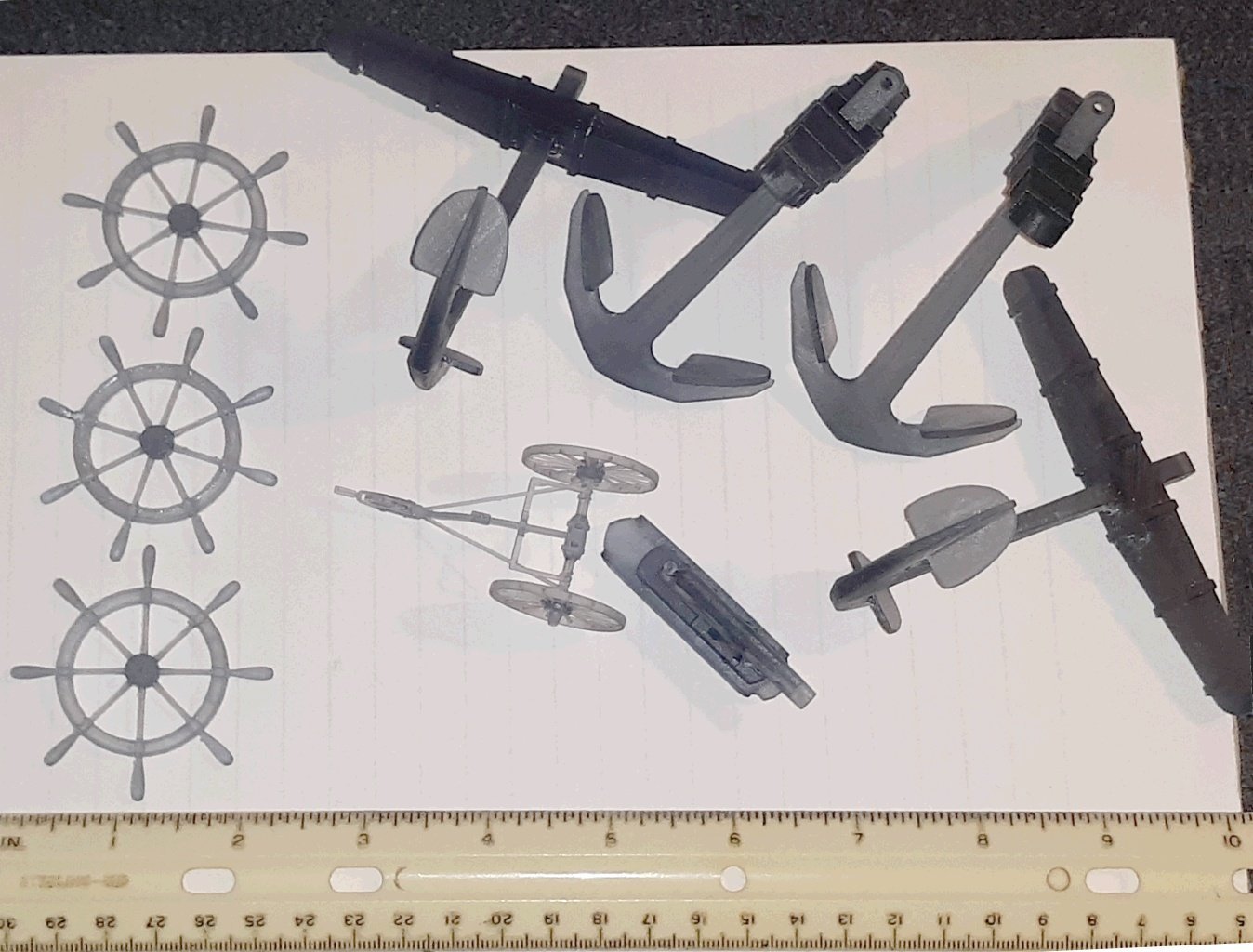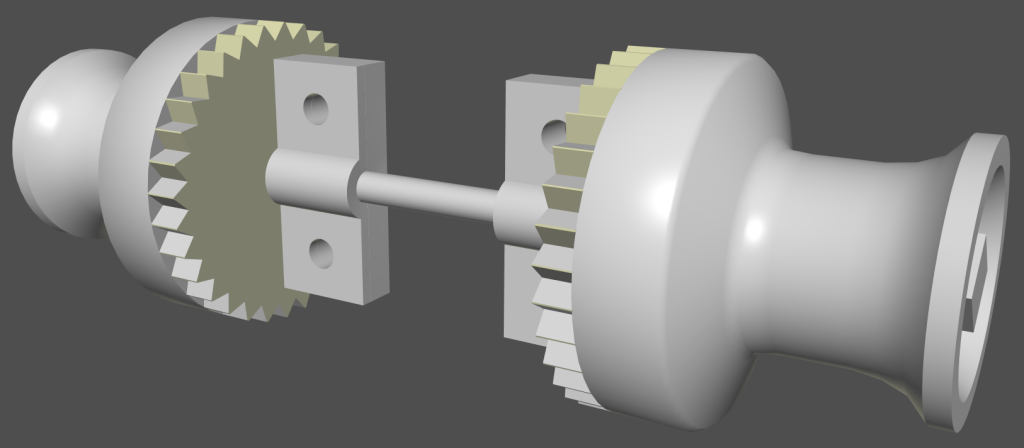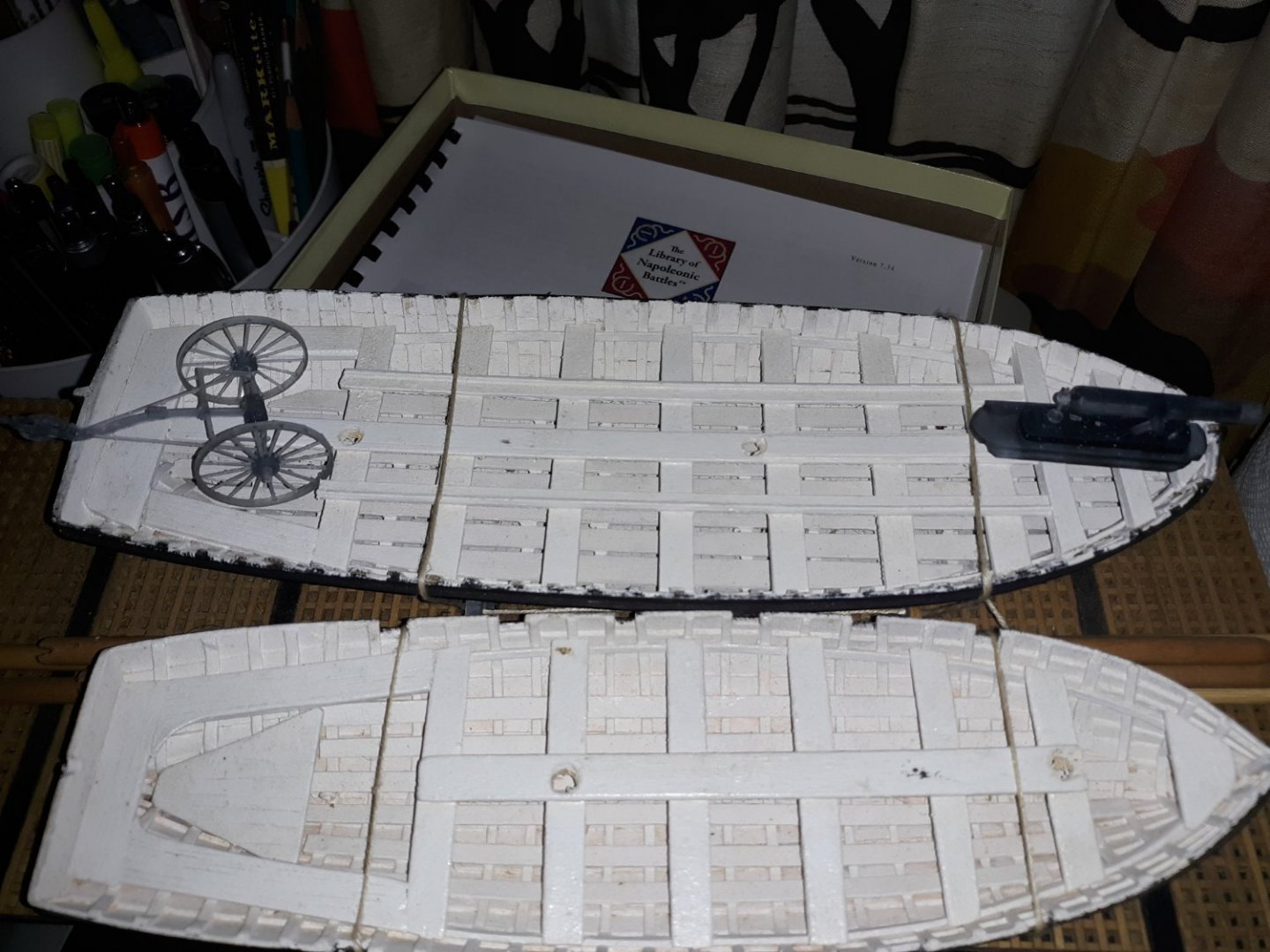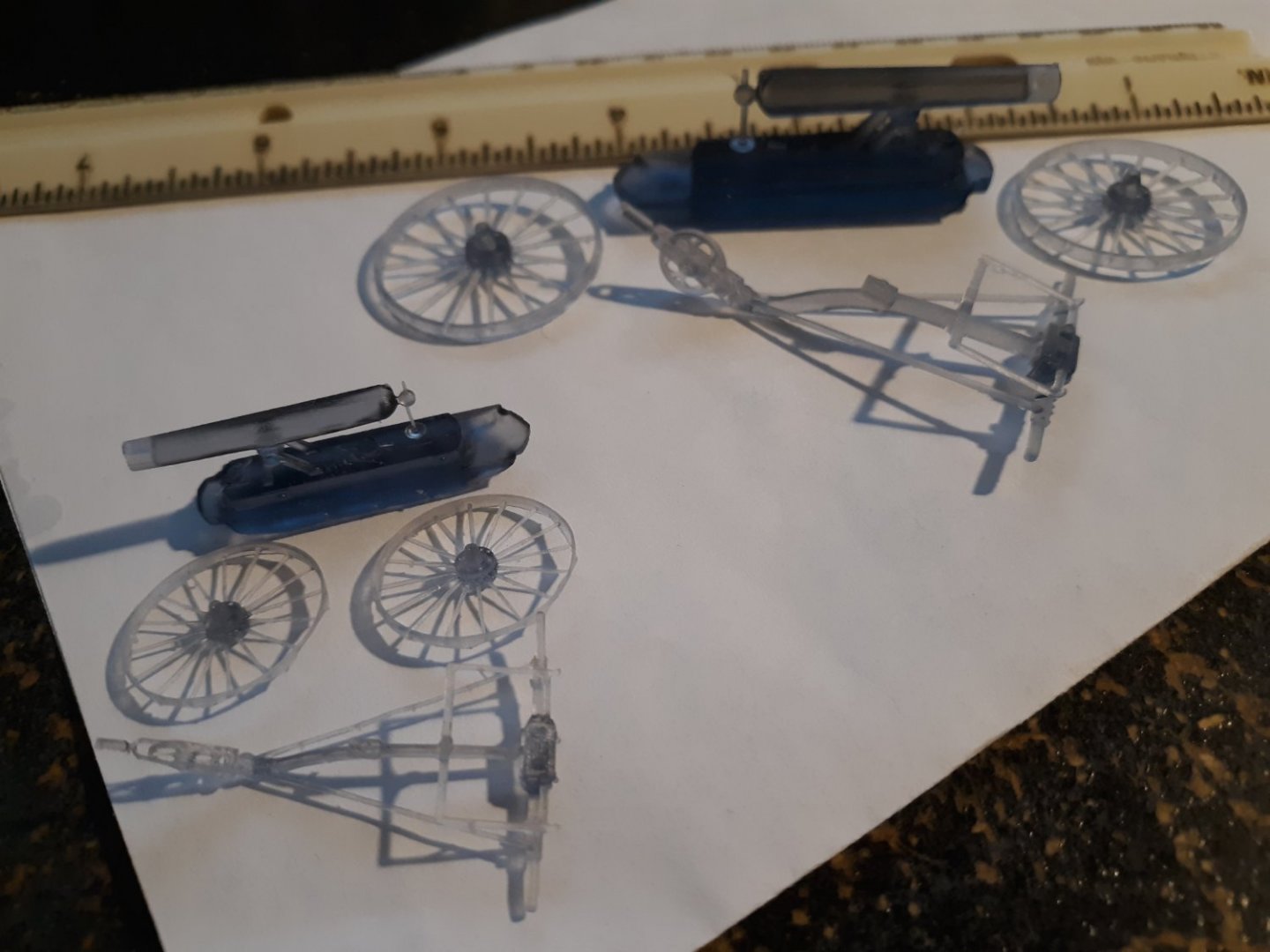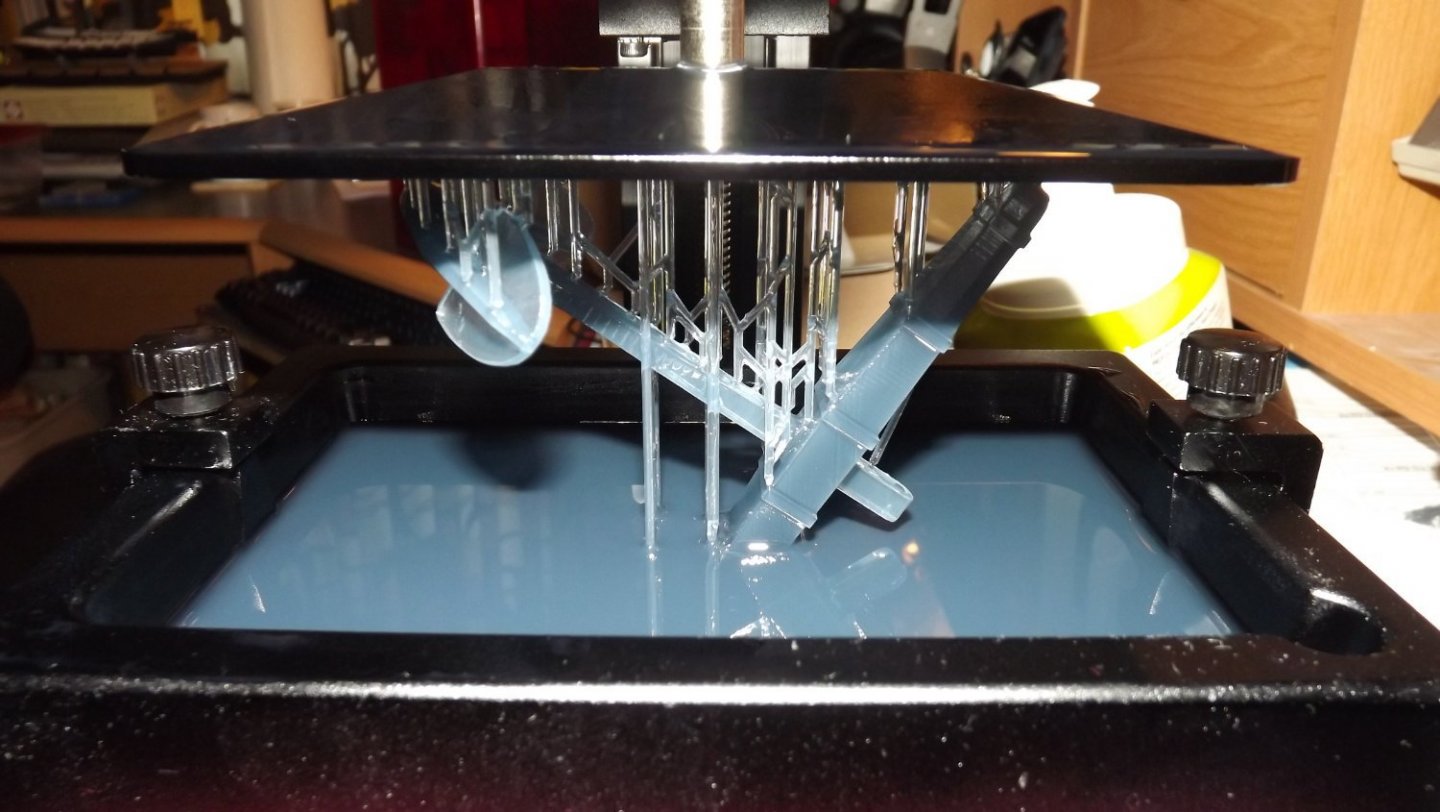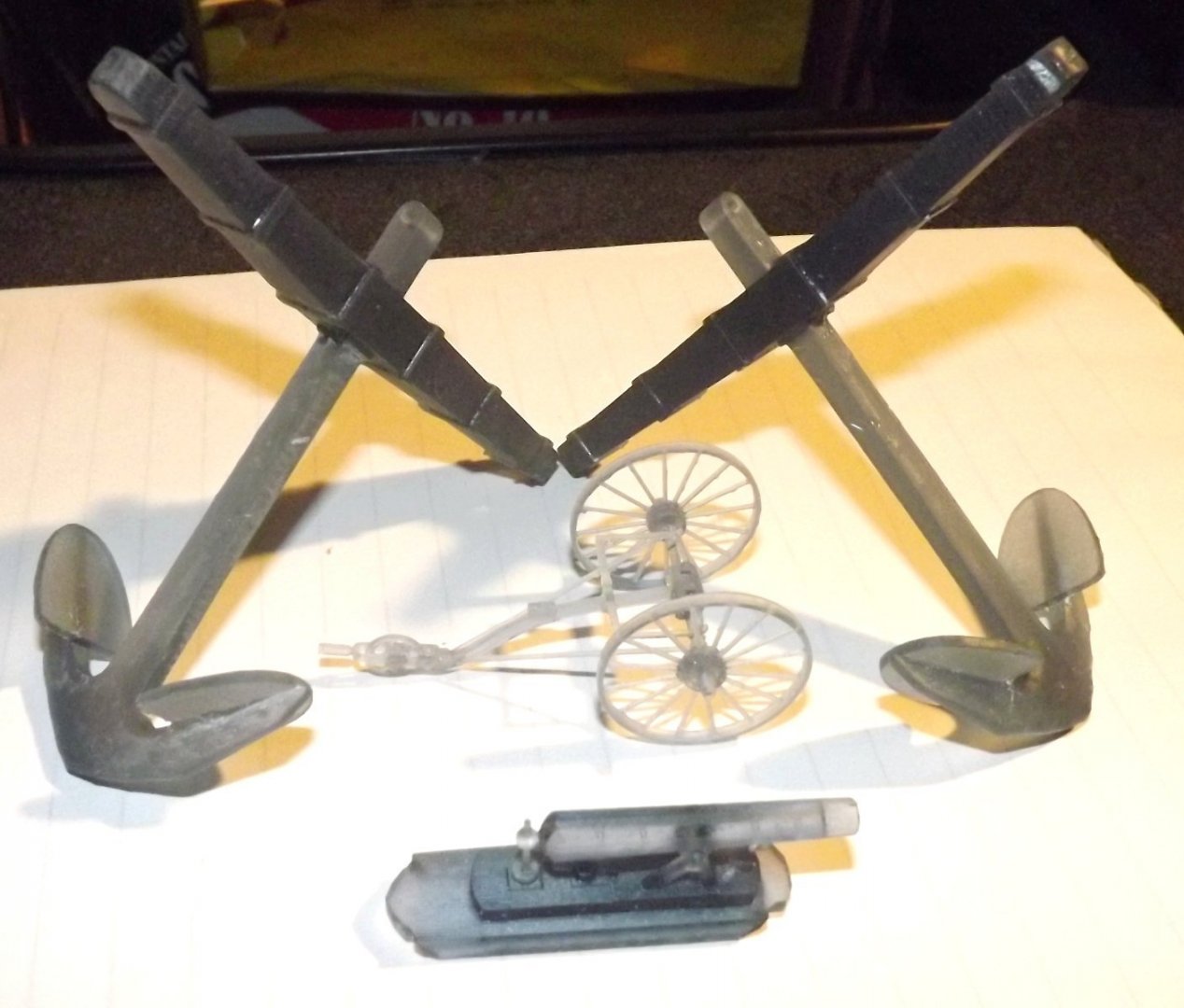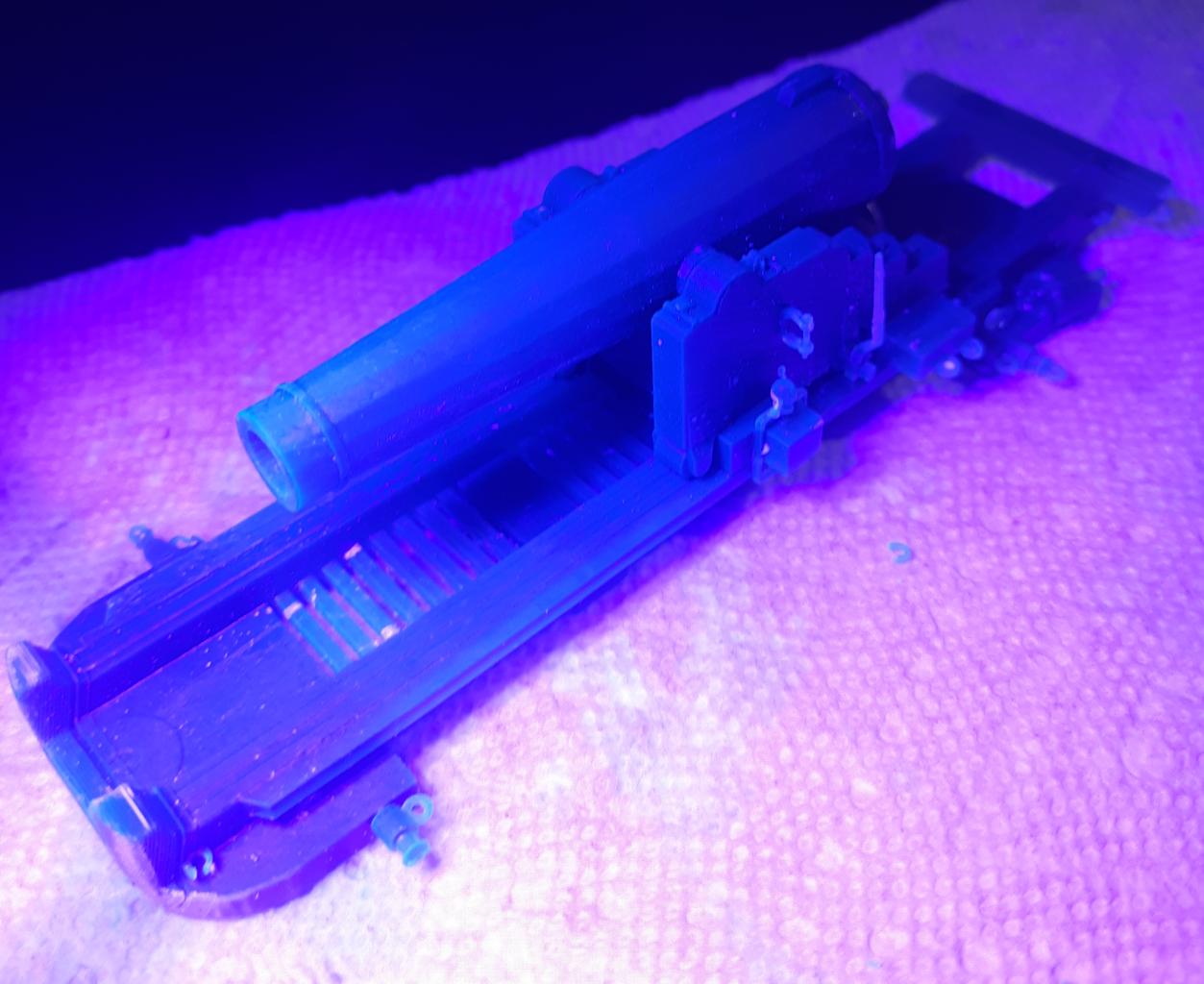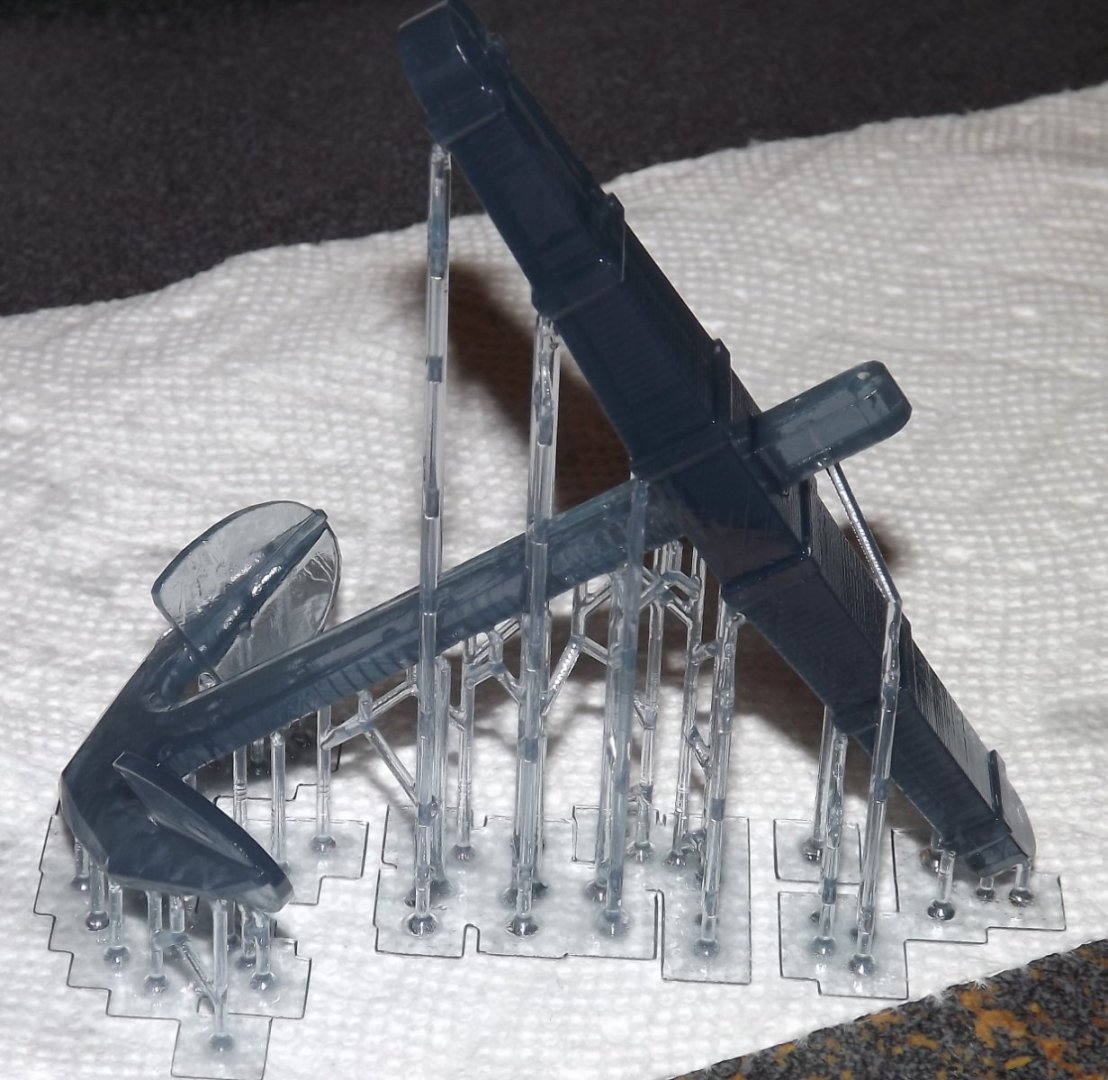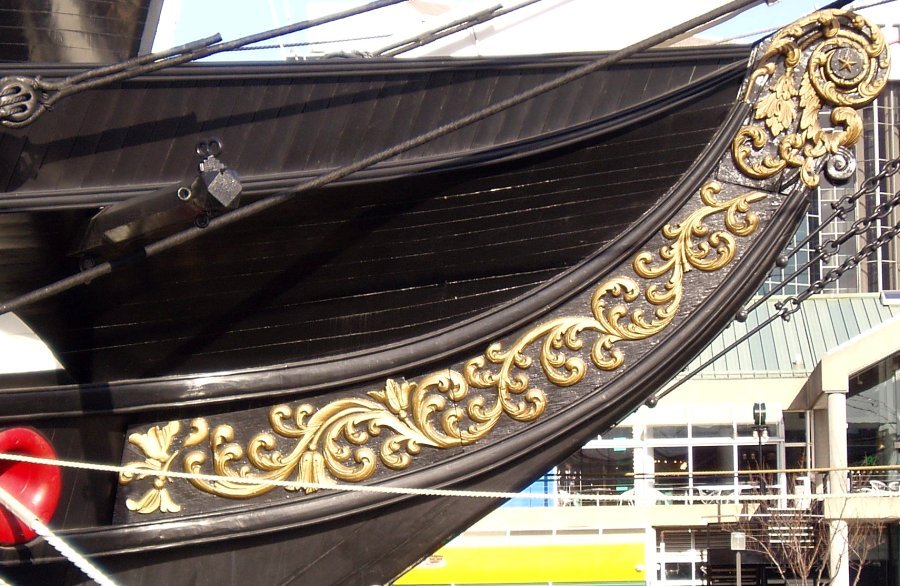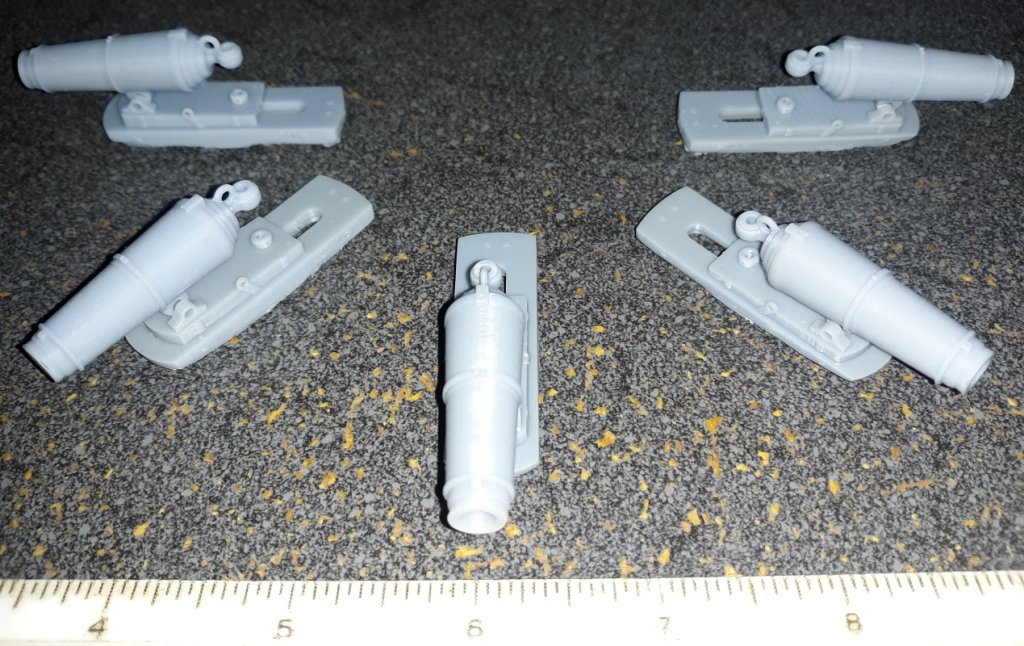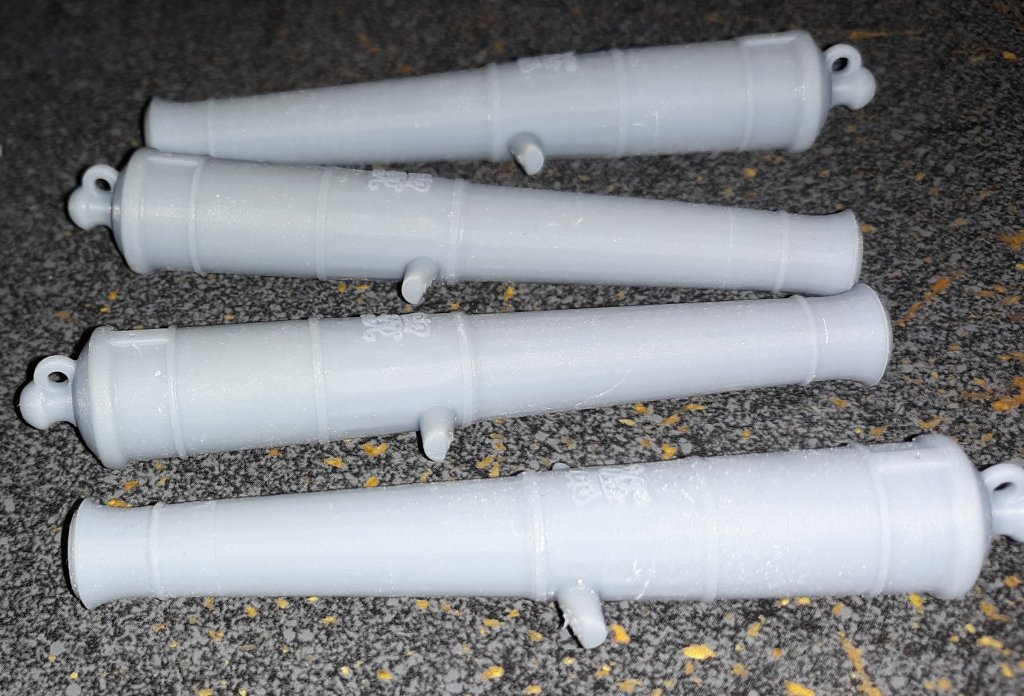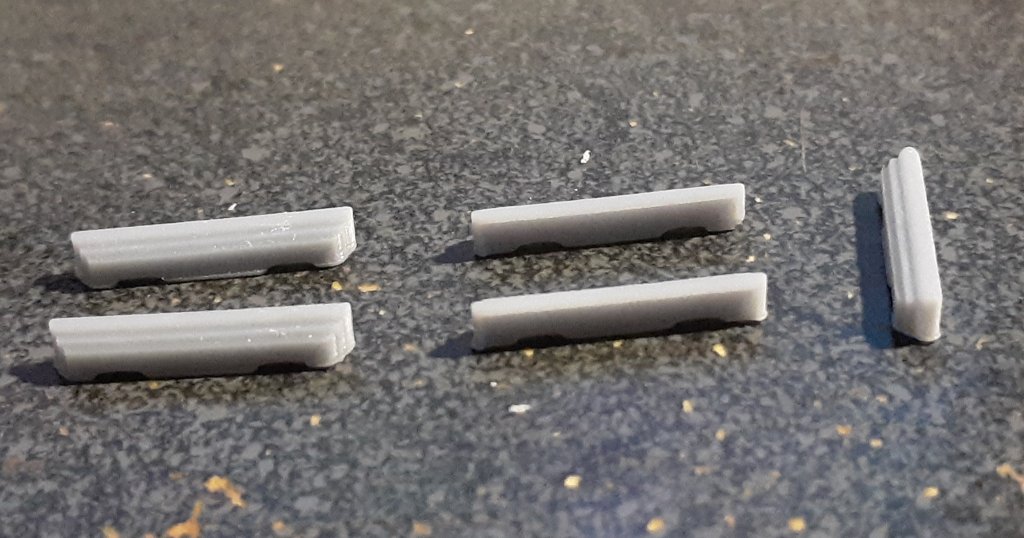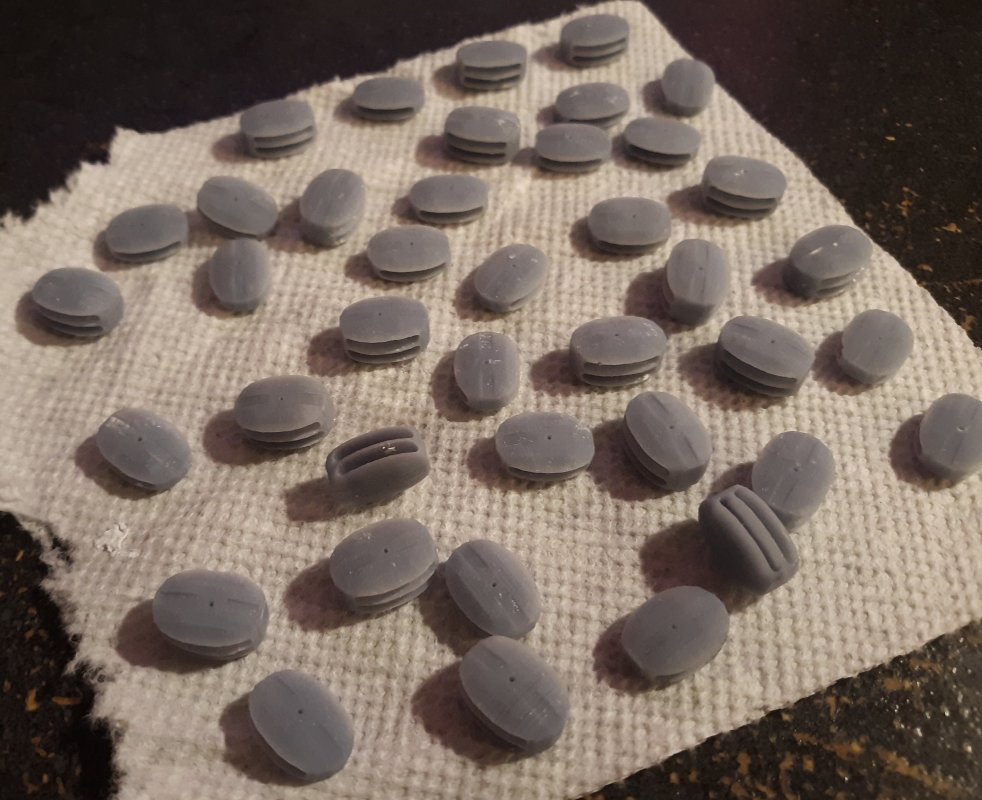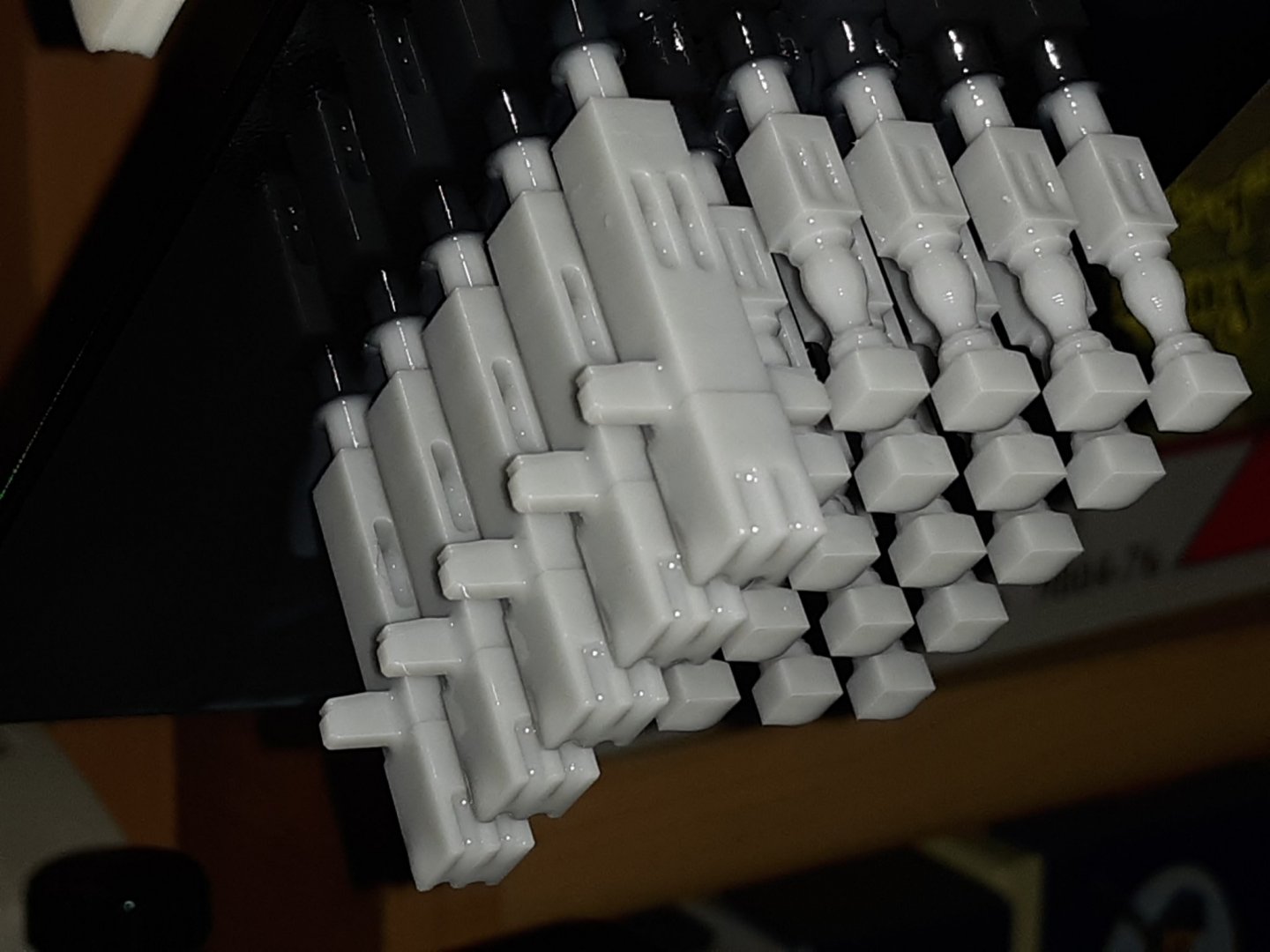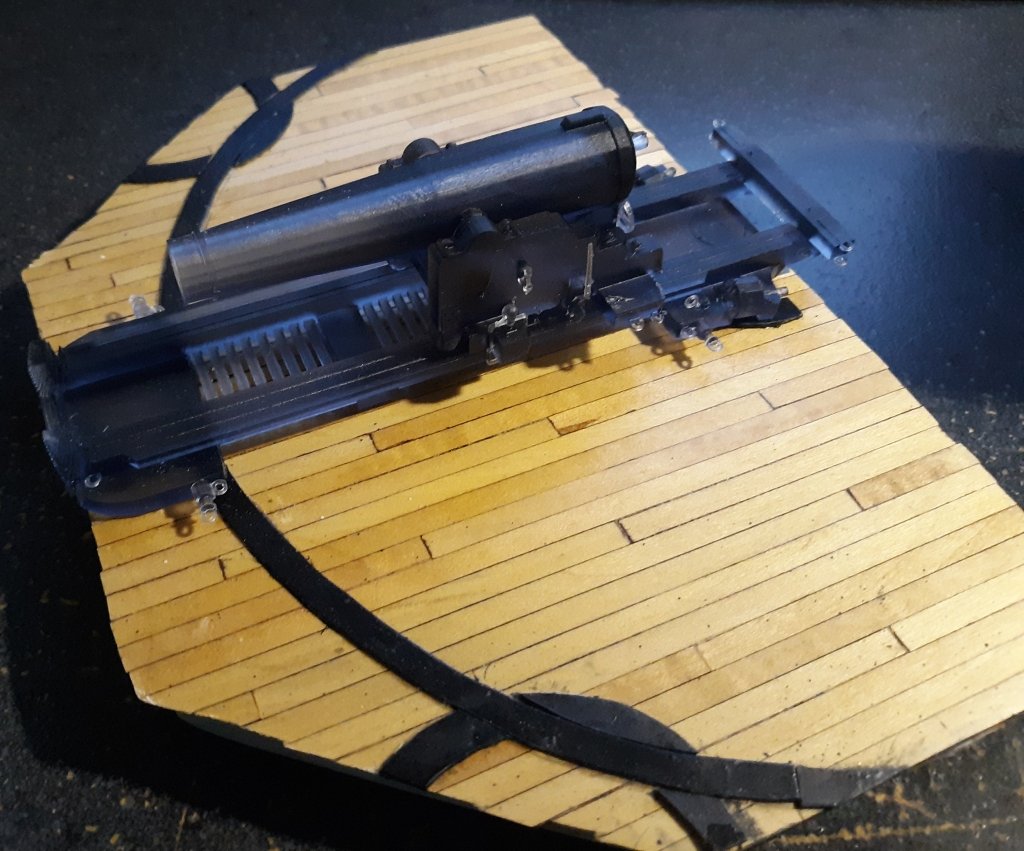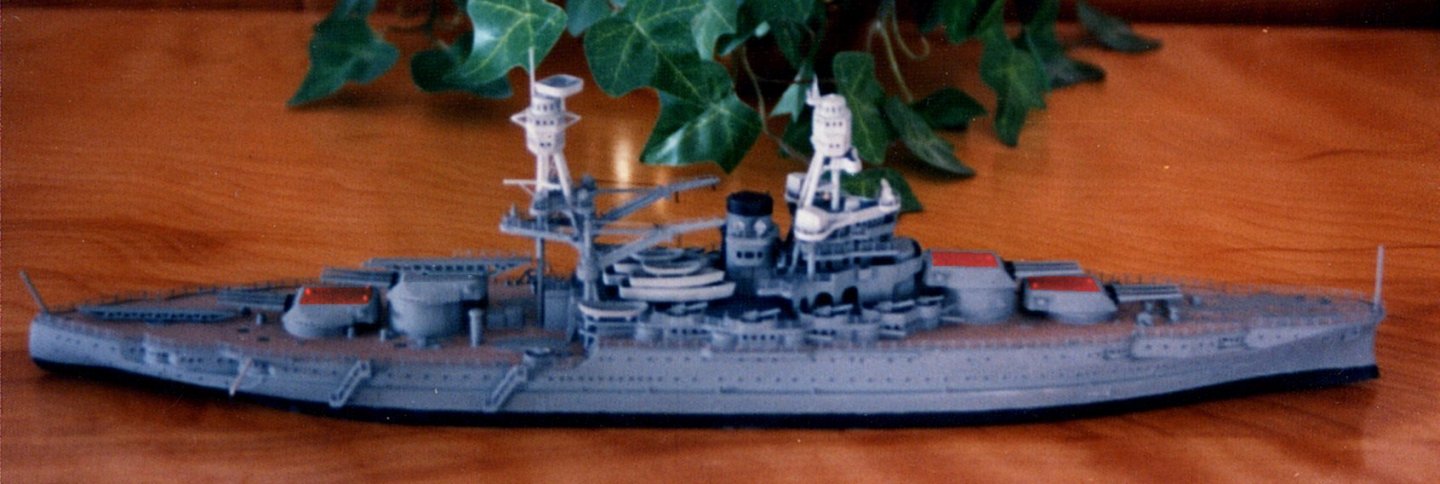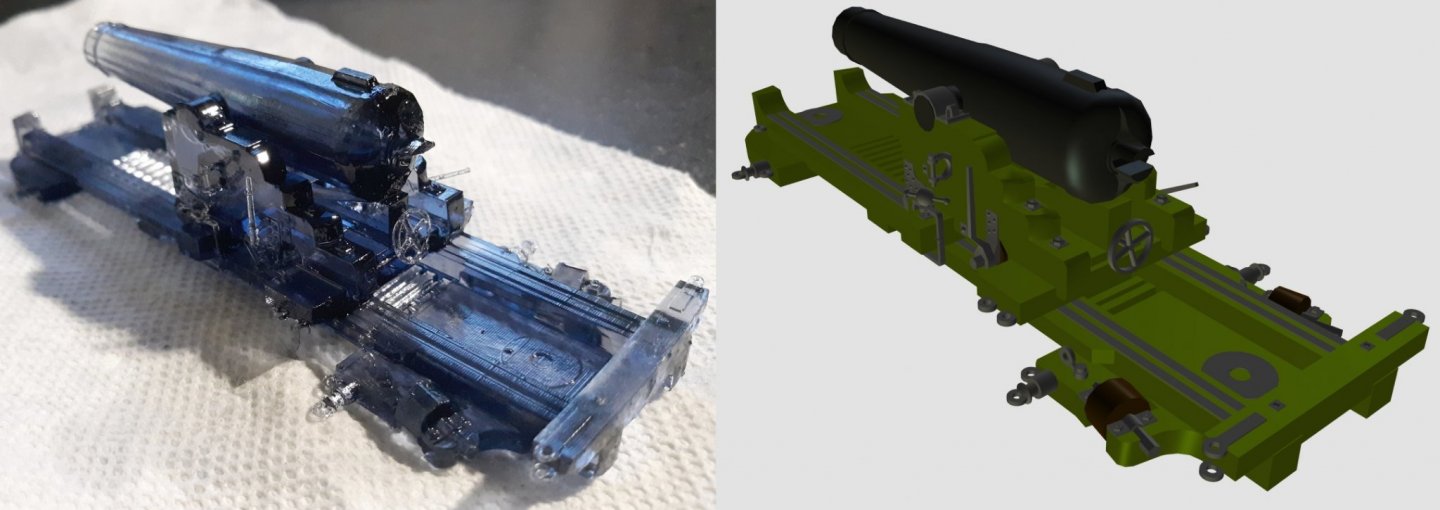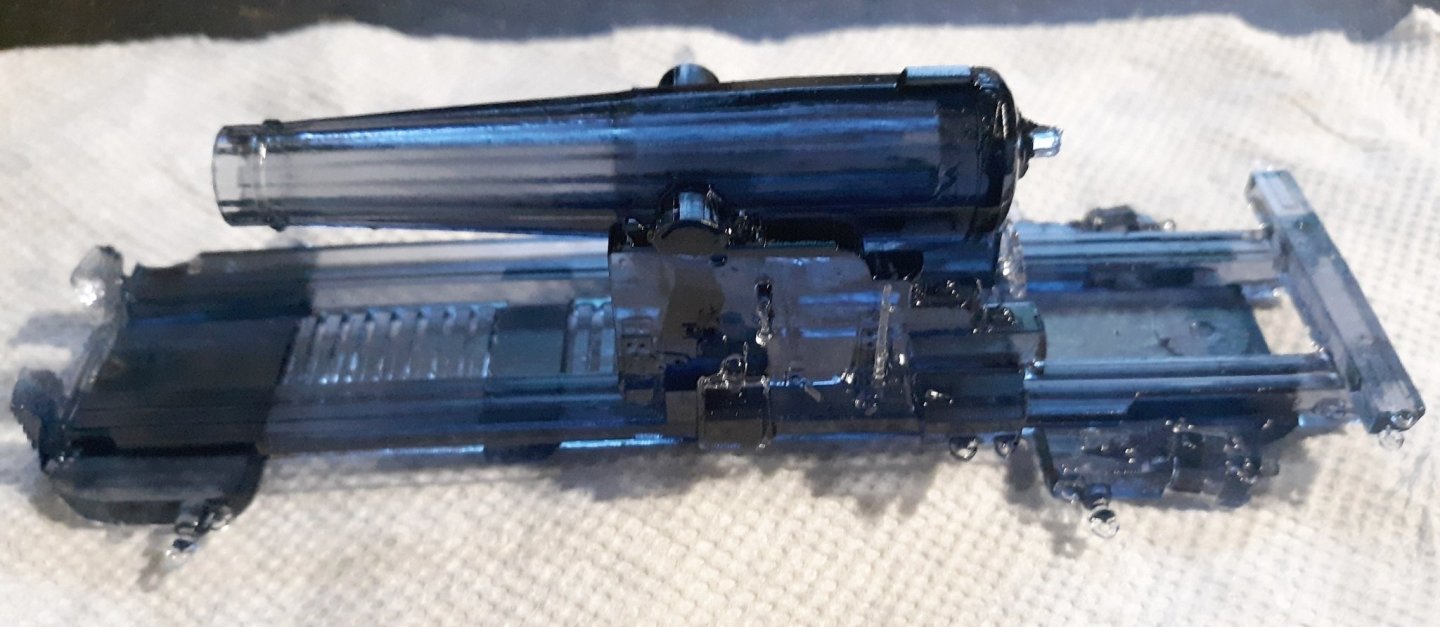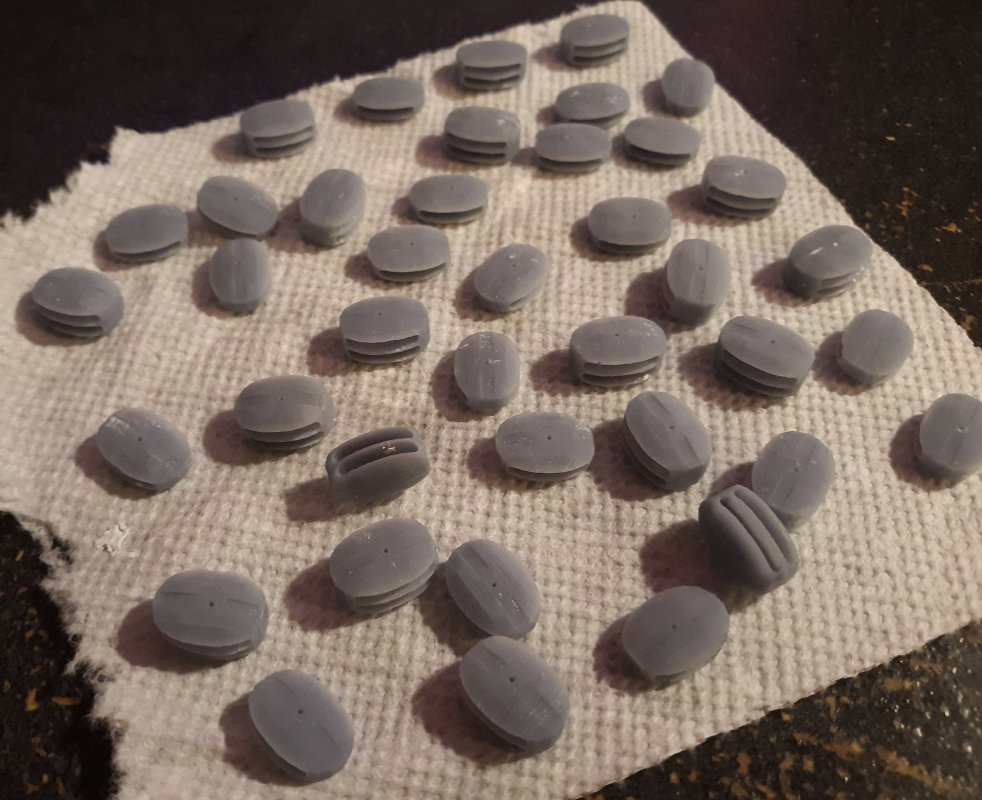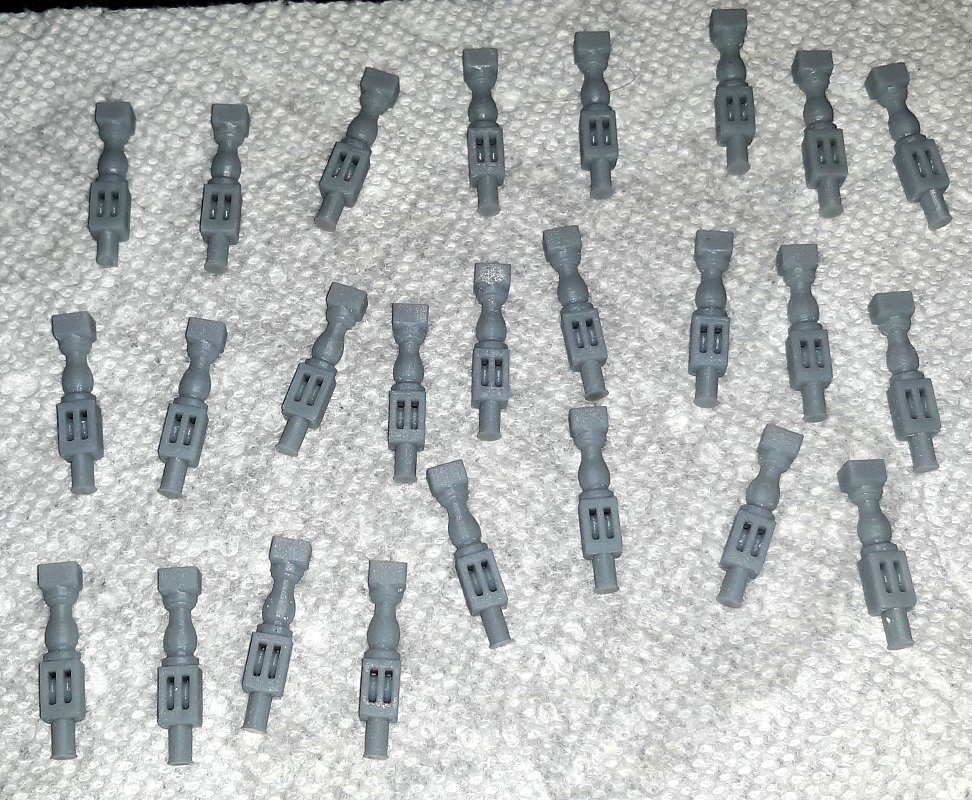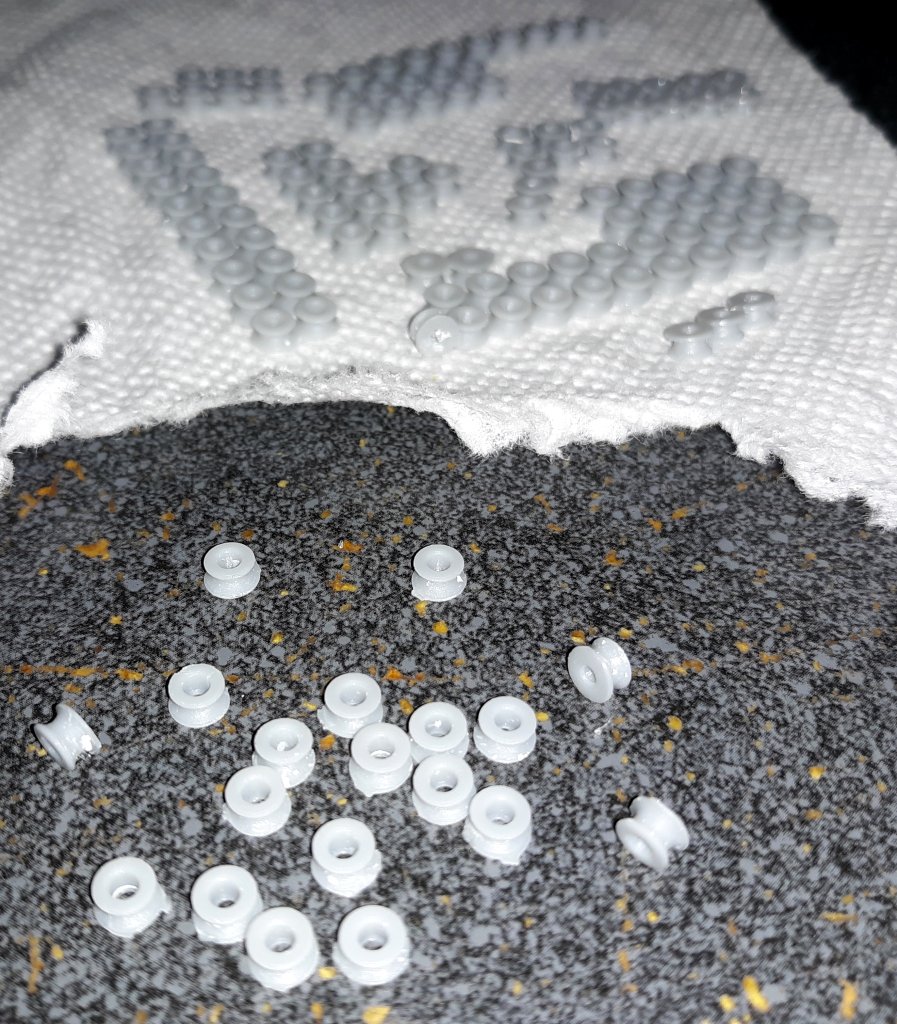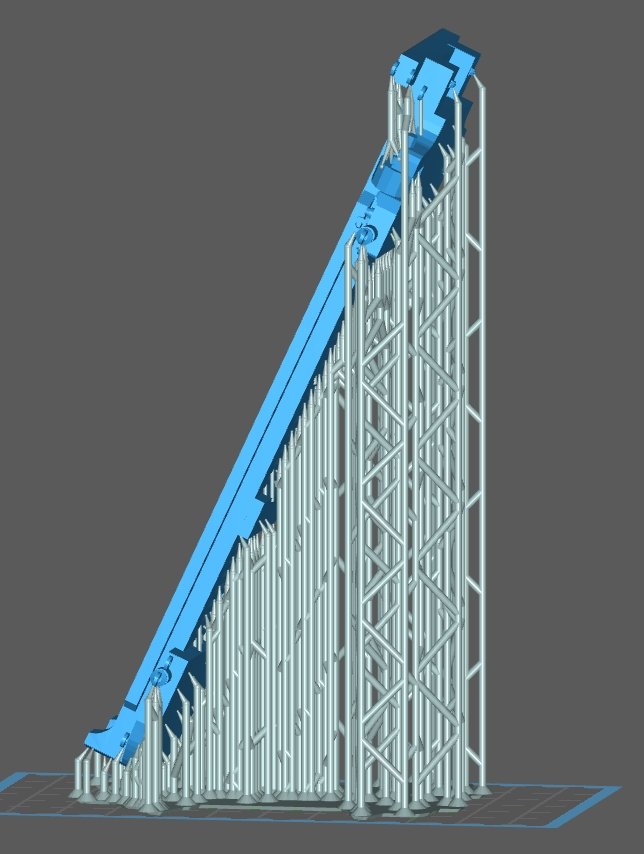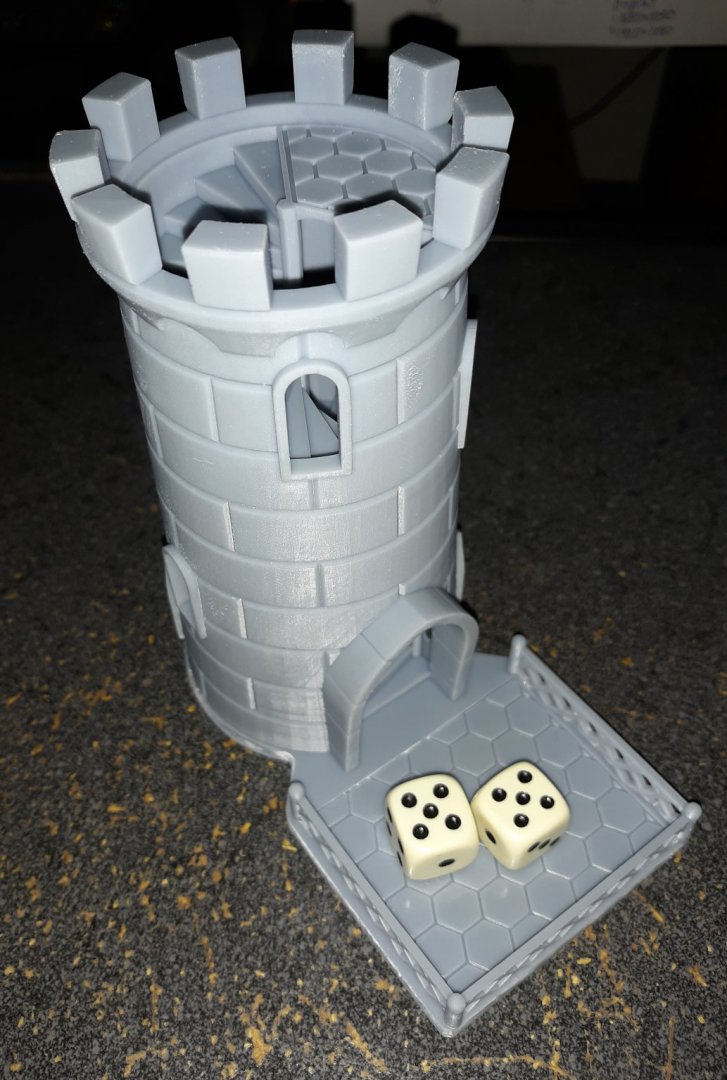-
Posts
874 -
Joined
-
Last visited
Content Type
Profiles
Forums
Gallery
Events
Everything posted by JerryTodd
-
Down-rigged the model so I could install the stuff I've been printing Boarding steps, oars for the boats, and pin rail stanchions, as well as painting some more.
- 553 replies
-
- sloop of war
- constellation
-
(and 3 more)
Tagged with:
-
Glued down the launch's rail and gave everything a preliminary coat of paint, including the boat gun, anchors, reprinted stanchions, and shells for blocks. Now I have to unrig the jury-rigged model so I can get to installing all this stuff.
- 553 replies
-
- sloop of war
- constellation
-
(and 3 more)
Tagged with:
-
While modeling the pivot point fittings for the launch's boat-howitzer, I got the idea to just model the cap rail with the fittings attached all in one piece. To fit in the printer, I had to make it in two parts. Once I prep the top of the hull, I'll glue this down and paint. I have to model stuff to go in the boats; oars, casks, maybe the gun's ammo boxes. I got a bottle of this resin, that's working so well, in "Sonic Grey" as well and printed the pivot gun with it. I redid the supports as well, and it came out nicely this time. But those facets on the barrel. I made the basic 3D model back in 2009 and just added details without updating the barrel... ...so I modeled a smoother barrel for the pivot gun and printed it. I'm done printing pivot guns for a while. The previous one I'll file to lessen those facets and these go on the boat.
- 553 replies
-
- sloop of war
- constellation
-
(and 3 more)
Tagged with:
-
I've played wargames since the 70's, have a bookshelf full of them, many of them Avalon Hill titles. Last Full Measure is based on the rules of Avalon Hill's 1977 Gettysburg.
- 553 replies
-
- sloop of war
- constellation
-
(and 3 more)
Tagged with:
-
All four anchors done, the boat howitzer, and the wheels for a friend... Now I need to paint this stuff. Here's the pivot guns, but I'm going to take another shot at printing them with a different arrangement of supports. If that works I'll probably make a set of book-ends with these This is the 3D model of the windlass for another model. It need it's pawls and a little size correction to be ready. The axle won't be printed, it's meant to have some brass rod there.
- 553 replies
-
- sloop of war
- constellation
-
(and 3 more)
Tagged with:
-
I have more hobbies than I have money or sense. One of them is designing board war games for which I provide the files for people to print them, cut them out, and play them - "print and play." I redid the artwork in my series of Civil War battles and released a new one on Lee's 1862 invasion of Maryland. I started that one in August? Planning to post in in September on the anniversary of the event, but It took longer to get the research in order and I didn't finish it till February. -=> http://UhlanGames.us
- 553 replies
-
- sloop of war
- constellation
-
(and 3 more)
Tagged with:
-
If I'm doing it Vic, it should be obvious that not a lot of brains or money is required because I'm incapable of meeting such requirements.
- 553 replies
-
- sloop of war
- constellation
-
(and 3 more)
Tagged with:
-
For two years until a few months ago, it seemed like all I did was work at "the job" with no time or energy left for myself. Well, one of those "Karens" came along and successfully relieved me of that burden, so now I have some time to do something for me (and a dozen other people wanting something done). Anyway, one of those other people asked me to 3D print a plate for mounting a thermostat in an outlet box for them, and while I had resin in the vat, I figured to get back to printing some parts for Constellation. Using the Siraya Tech Build "Smoky Black" resin I used on the pivot gun a few posts back, I tried printing the boat howitzer again, only this time with the wheels and carriage separate, and the gun on the sled. It came out nicely except it was scaled to about 1:76 for some reason. I re-scaled it to 1:36 and tried again and it came out perfectly. (I think clicking on the pic will let you see it full size) Next I went for one of the anchors, which came out perfectly, so I pressed my luck and printed a second one with the same result. The two anchors and the boat howitzer, all in 1:36 scale. I need two more anchors, but I had to print some steering wheels for someone else. After that, I opted to go for the pivot gun again. It didn't come out perfectly, but I can fix what went wrong and use this print, just like before. I may give it one more shot after rearranging the supports where the little failures took place, and if that works, print a pair and maybe make static models of these? Second printing of the pivot gun here being zapped with UV light to cure the resin completely. My friend that I printed the wheels for needs a sampson-post windlass for the same schooner model as well, so I'm in the 3D modeling software making one from scratch cause I couldn't find any models on line. After that I'll come back and print the other two anchors and reprint the stanchions, fairleads, bullseyes, block shells, and other stuff for Constellation in this better resin.
- 553 replies
-
- sloop of war
- constellation
-
(and 3 more)
Tagged with:
-
A functional hull should be glassed outside and resin inside. It need not be epoxy, polyester resin is cheaper and will do the job just fine. The glass helps "shrinkwrap" the hull so any seams that open even a little bit don't let water in. Without the cloth, the resin will just crack, water will get in and swell the wood, expanding the crack, and deforming the hull. Building Wooden Hulls for RC
-
Lovely little plywood clinker. I want to build a boat I can car-top alone as a chase boat when sailing my models. Nothing so pretty, maybe a basic pram.
- 28 replies
-
- frigate
- enterprize
-
(and 2 more)
Tagged with:
-
I started using Anim8or in the 90's to make new 3D models for a WWI flight Sim, because it was free, saved in 3DS, and saved in plain text that could be edited. It's still out there at: www.anim8or.com It's not Blender, or any other "modern" 3D editing tool by any measure, but I'm at home with it. My problem is if it's useful for making that viney 3D carved stuff, like below, I haven't found a way that isn't tedious enough to be maddening. As for working in 1:36 scale, the larger the scale, the more detail that lacking, compared to what can be left out of say, 1:72 and still appear highly detailed. But these being RC models, I can still see a 1:36 scale ship a hundred yards away.
-
Some carronades and Blomfield 18 pdrs for Macedonian from STLs by Tim Bowman that I altered slightly. Boarding steps, shells for blocks, bitts and stanchions, and a pivot gun for Constellation, all 3D models made in Anim8or free 3D software by me. (All in 1:36 scale) I'm trying to model the filigree vine-work of Constellation's head carvings, but it's difficult. The basic geometry of guns and stanchions is much easier for me.
-
I bought a copy from the designer, Tom Gilmer, back when I was on the crew in 1981, and redrew them to 1:20 scale for the model. The plans were also very different than the actual boat in a lot of places; number of gunports, some deck details, etc. The drawing is actually a work in progress and in some places I made something from photos, and added it to the drawing-after-the-fact. (The referenced drawing is in post #1 of this log) The designer is no longer alive and I don't know if the original drawings are available except possibly from the Maryland Historical Society
- 79 replies
-
- pride of baltimore
- privateer
-
(and 3 more)
Tagged with:
-
My elementary school library had "The Captain from Connecticut" by C.S.Forrester and it was through that book that I discovered Hornblower. I've read it many time through, the last few times in chronological order. My little boat of over 40 years, is named Lydia. O'Brian's Aubrey/Maturin series was good, but never grabbed me the same way. I hated Bolitho who just happened to be at every major naval engagement in history in a pivotal role, even if they were a thousand miles apart on the same day, except maybe Salamis or Midway. Another series I found by chance at a yard sale, and recommend is the Nathanial Drinkwater series by Richard Woodman.
-
What you see set is all the sail the model's getting. The real boat might set stuns'ls, a fisherman, and a ringtail (never set during my time aboard), beyond that, but controlling that stuff remotely is more than I could manage to figure out.
- 79 replies
-
- pride of baltimore
- privateer
-
(and 3 more)
Tagged with:
-
I knew Jeffery Footner, worked on his house in Fells Point, and we discussed Constellation a lot over beers at the Whistling Oyster or John Stevens. I don't know why, but he NEEDED Constellation to be the frigate. He did a lot of good research for his book, but in the book he tried to bend it to fit his agenda. Some of the data had been debunked long ago, but still got regurgitated as evidence. They say you can't talk politics or religion with people, with Jeff, you didn't talk about Constellation. Another fella that NEEDS Constellation to be the frigate has This Page claiming that a t'gallant pole as opposed to separate t'gallant and royal masts proves a drawing is Constellation somehow.
-
Keep in mind the AL kit's hull is taken from the lines of the sloop-of-war which is longer and slightly wider than the frigate's. The kit is basically a model of the fantasy frigate Baltimore was trying to achieve from 1956-1998. The sail plan they presented had little to do with the frigate as they were trying to get away with using the sloop's spars they had on hand. The bottom line is it doesn't matter what spar dimensions are used on this kit as nothing about it has anything to do with the 1797 frigate anyway, best bet is to use what the kit supplies.
-
It's transparent aluminum from Star Trek 4
- 553 replies
-
- sloop of war
- constellation
-
(and 3 more)
Tagged with:
-
Designed and printed a few items, some small bullseyes, improved stanchions, shells for blocks, and a few failed attempts at other items. My latest try at the pivot gun wasn't great, but it was the best so far. The front of the slide and the cascabel didn't come out right, but I can reprint just those portions and glue them on to make this print usable. It was printed with a different resin that's a "smokey black" translucent color, and is supposed to be structurally stronger.
- 553 replies
-
- sloop of war
- constellation
-
(and 3 more)
Tagged with:
-
It's been a while, but I'm making another attempt at printing the pivot guns. I separated the gun/carriage from the slide and taking a shot at printing the slide alone. This is a second attempt, the first already failed, so I beefed up the supports and I got a bottle of new resin that's supposed to be stronger. The picture shows the model with it's supports that's sent to the printer, and it's printing as I type this. I should know in an hour or two if it's failed again, other wise it'll take about 10 hours to print completely.
- 553 replies
-
- sloop of war
- constellation
-
(and 3 more)
Tagged with:
-
For those following my other logs, you're aware I got a 3D printer and have made a couple of items for those models, and I'm working on further 3D model parts to print. This model too, will get something from the resin vat, though I can't think of many things at the moment. Her swivel guns come to mind right-off, maybe drums for the windlass, and crew figures, and her 4 carriage guns, of course.
- 79 replies
-
- pride of baltimore
- privateer
-
(and 3 more)
Tagged with:
-
By-the-way, A German fellow (I think) did an RC Enterprize a few years back. I don't know what scale it is, I think it's 1:48. Here's a video he posted some years ago, and I haven't seen anything from him in some years now. That's an on-board camera on top of the boats, he's posted that video as well.
- 28 replies
-
- frigate
- enterprize
-
(and 2 more)
Tagged with:
-
There shouldn't be a difference really, not with the anchor. This thing, for instance, is about as big at the printer can handle, and it has a couple of flaws at the base because in a couple of places the suction of the last printed layer almost overcame the adhesion to the build plate, so there's a place that appears to be de-laminating right where the little patio attaches to the tower in the picture. Otherwise it came out beautifully. (click it to see it larger) On things that don't have a flat face to attach to the build plate, you need those supports to hold them and connect them so the plate has a means to pull the part out of the vat. It's a tug of war with every layer printed, and you want the build plate to win every time. It's being able to pull the thing free of sticking to the film at the bottom of the vat that matters, and the supports have to be strong enough to do that job. My set up seems to be weak where they attach to the part itself. The layer sticking to the vat pulls the part loose from the supports. I can change those parameters, I basically have them at their default values. Rather than waste resin with trial and error, I've been looking at YouTube videos on the subject to learn what people with more experience are doing. These folks seem to print mostly fantasy figures with wings, swords, capes, flowing garments, and all sorts of elaborate and fragile looking appendages; my models are nothing compared to that in terms of sticky-outty bits. Notice where this support detachment happened with this pair of wheels (red arrows), causing one spoke not to print and another to be deformed.
- 553 replies
-
- sloop of war
- constellation
-
(and 3 more)
Tagged with:
About us
Modelshipworld - Advancing Ship Modeling through Research
SSL Secured
Your security is important for us so this Website is SSL-Secured
NRG Mailing Address
Nautical Research Guild
237 South Lincoln Street
Westmont IL, 60559-1917
Model Ship World ® and the MSW logo are Registered Trademarks, and belong to the Nautical Research Guild (United States Patent and Trademark Office: No. 6,929,264 & No. 6,929,274, registered Dec. 20, 2022)
Helpful Links
About the NRG
If you enjoy building ship models that are historically accurate as well as beautiful, then The Nautical Research Guild (NRG) is just right for you.
The Guild is a non-profit educational organization whose mission is to “Advance Ship Modeling Through Research”. We provide support to our members in their efforts to raise the quality of their model ships.
The Nautical Research Guild has published our world-renowned quarterly magazine, The Nautical Research Journal, since 1955. The pages of the Journal are full of articles by accomplished ship modelers who show you how they create those exquisite details on their models, and by maritime historians who show you the correct details to build. The Journal is available in both print and digital editions. Go to the NRG web site (www.thenrg.org) to download a complimentary digital copy of the Journal. The NRG also publishes plan sets, books and compilations of back issues of the Journal and the former Ships in Scale and Model Ship Builder magazines.



